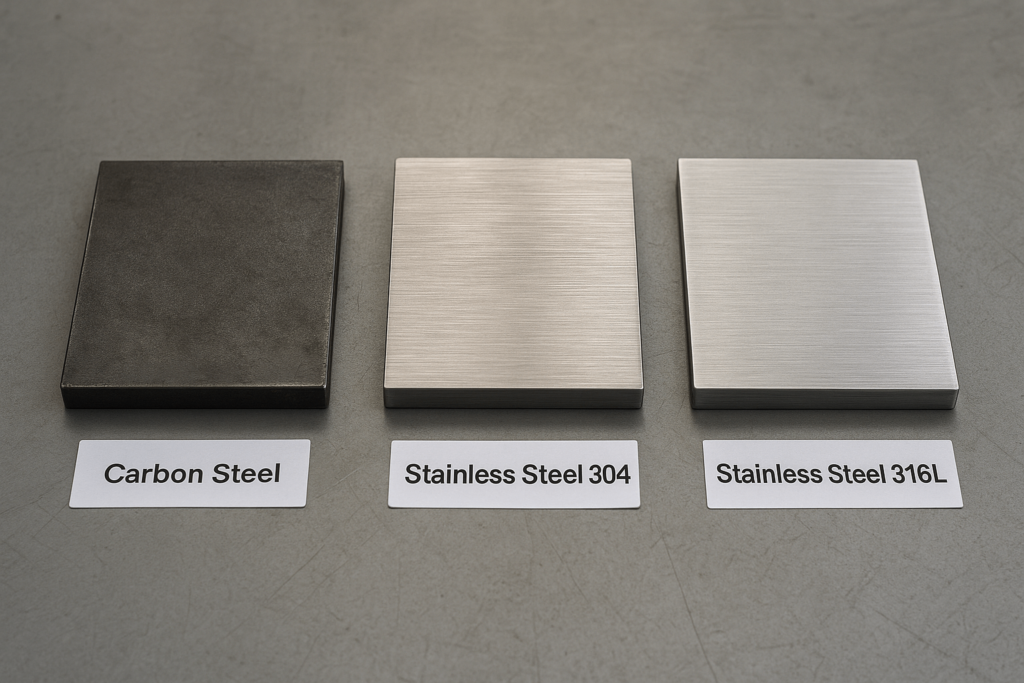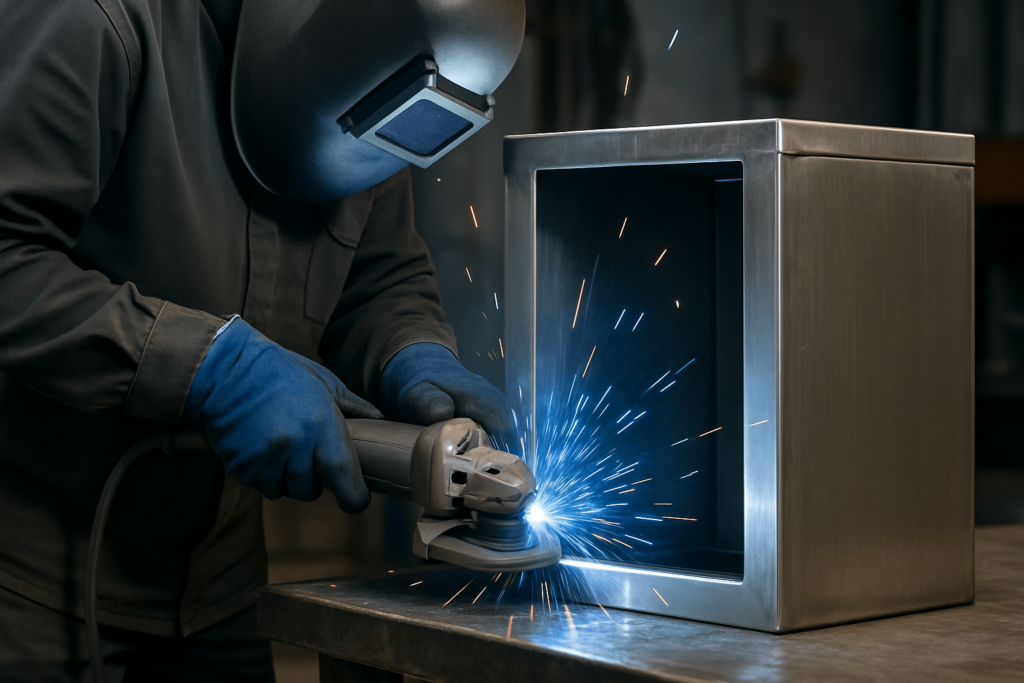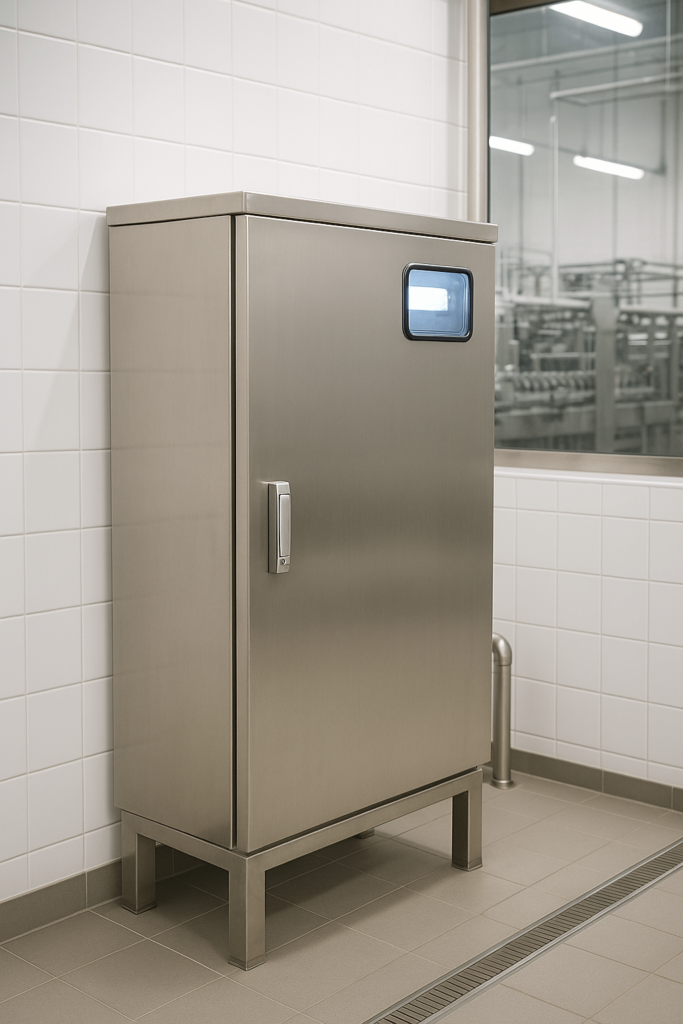Introduction: More Than Just a Box - The Unsung Hero of Industrial Control
In the heart of any large-scale industrial operation—be it a sprawling chemical plant or a high-output power generation facility—lies an immense challenge: managing the constant flow of data. Hundreds, sometimes thousands, of field signals must be reliably routed to the central brain of the operation, the Distributed Control System (DCS) or Programmable Logic Controller (PLC).
In this intricate network, the marshalling cabinet stands as the unsung hero. It is the critical central nervous system that brings order to this potential chaos. Far from being a simple steel box, a marshalling cabinet is a sophisticated interface where the physical world of field wiring meets the logical world of the control system.
Its design and construction are paramount to overall system reliability and safety. This guide offers a deep, practical exploration of marshalling cabinet design, presented from the unique perspective of a metal fabricator. We will delve into how the physical construction, material science, and fabrication quality of the enclosure itself form the bedrock of a robust and dependable industrial control system.
Section 1: The Fundamental Problem: Why Marshalling is Non-Negotiable
Before diving into design specifics, it’s crucial to understand the fundamental purpose of marshalling. The need arises from a core logistical problem that would otherwise make large-scale automation nearly impossible to implement and maintain, leading to significant project delays and cost overruns.
The Core Challenge: Bridging the Gap Between Field and Control Room
In any large facility, signals from field instruments are consolidated in local junction boxes. From there, high-density “home run” cables are run to a central control room. These cables often contain a random assortment of signal types—Analog Inputs (AI), Digital Inputs (DI), Analog Outputs (AO), and Digital Outputs (DO).
Attempting to connect these mixed-signal field cables directly to the fixed-channel I/O cards of the system cabinet would create a logistical nightmare. This is the problem the marshalling cabinet solves through a process known as cross-wiring. It provides a centralized termination point where each wire is landed, then “cross-connected” to route the signal to the correct system I/O card. This meticulous organization of instrumentation signals is foundational to efficient commissioning and maintenance.
Marshalling Cabinet vs. Junction Box: A Critical Distinction
The terms “marshalling cabinet” and “junction box” are often confused, yet they serve fundamentally different roles. A junction box is a simple consolidation point, a passive electrical enclosure where wires are spliced into a larger cable for the long run back to the control room.
A marshalling cabinet, in contrast, is an active routing hub. It is a far more complex and integral part of the control architecture, enabling not just termination but also signal conditioning, isolation, and the critical cross-wiring function. The following table clarifies this distinction.
| Feature | Marshalling Cabinet | Junction Box |
|---|---|---|
| Primary Function | Routes and organizes signals, ensuring proper I/O assignment. | Collects and consolidates field device wiring for simplified cable management. |
| Signal Management | Enables cross-wiring, signal conditioning, and redirection to specific I/O modules. | Provides a direct, passive pass-through connection with no internal signal redirection. |
| Complexity | High. Supports multiple I/O types, power distribution, and system integration needs. | Low. Serves as a simple wiring consolidation point. |
| Key Components | Includes terminal blocks, IS barriers, surge protectors, relays, and power supplies. | Contains only basic terminal blocks for wire termination. |
Section 2: The Physical Foundation - An Expert's Guide to Enclosure Selection
The reliability of every component inside a marshalling cabinet begins with the physical integrity of the enclosure. As metal fabrication experts, we understand that material choice and construction quality are foundational decisions that directly impact the longevity, safety, and Total Cost of Ownership (TCO) of the entire control system.
The Material Science Showdown: Choosing Your Champion
Selecting the right industrial cabinet material is a strategic balance of corrosion resistance, strength, and cost. For a procurement manager, this choice directly influences the long-term asset value.
Carbon Steel: This is the most economical choice for controlled, indoor environments. While strong, it is susceptible to rust and relies entirely on a high-quality protective powder coating for its defense against moisture.
Stainless Steel 304: This is the industry’s versatile workhorse. Composed of 18% chromium and 8% nickel, Type 304 offers excellent resistance to a wide range of corrosive agents. It is the standard for applications involving washdowns, such as in the food and beverage industry, and for general outdoor use.
Stainless Steel 316/316L: This is the premium material for harsh environments. The addition of 2-3% molybdenum dramatically enhances its resistance to corrosion, particularly from chlorides found in marine atmospheres and aggressive chemicals. This makes Type 316L the mandatory choice for coastal installations and chemical plants, ensuring maximum asset life.

Decoding Protection Ratings: Beyond the Numbers (NEMA vs. IP)
Two primary standards define an enclosure’s protection level: NEMA (National Electrical Manufacturers Association) and IP (Ingress Protection). For international procurement, understanding their differences is key to mitigating risk.
While often seen as interchangeable, a direct conversion is misleading. The IP rating system focuses solely on ingress protection against solids and liquids. A NEMA rating is more holistic, also specifying performance against factors like corrosion and ice formation.
For example, a NEMA 4X rating is often equated to IP66, as both protect against powerful water jets. However, the “X” in NEMA 4X explicitly mandates corrosion resistance—a critical factor for TCO that the IP66 standard does not address.
Construction Integrity: What to Look for in a Quality Build
The datasheet specifications of an enclosure are only as good as its fabrication quality. A wholesale buyer should look for signs of manufacturing excellence that guarantee long-term performance.
Seams and Welds: High-quality enclosures from a reputable electrical enclosure manufacturer feature continuously welded seams that are ground smooth. This creates a single, solid piece of metal at the corners, eliminating gaps that could compromise the seal or initiate corrosion.
Hardware and Gaskets: The choice of hardware is critical. High-quality stainless steel hinges and latches resist corrosion and provide secure closure. The gasket should be a seamless, poured-in-place foam gasket to ensure there are no joints that could fail with age.
Structural Strength: The enclosure must have the structural strength to support its internal components without flexing. This is achieved through proper material gauge selection and a robust frame construction that can handle the specified load-bearing capacity.

Section 3: Inside the Cabinet: A Tour of the Core Electrical Systems
While the enclosure provides physical protection, the internal components perform the cabinet’s primary functions. A well-designed internal layout is crucial for reliability and maintainability.
The Connection Hub: Selecting the Right Terminal Blocks
Terminal blocks are the most numerous components, providing secure connection points for every wire. The choice of connection technology impacts installation speed and long-term reliability.
Screw Clamp: This traditional technology is versatile and ideal for high-current applications. However, installation is more labor-intensive, and screws can potentially loosen in high-vibration environments.
Spring Clamp: This technology uses a pre-stressed spring to maintain constant pressure on the wire, making it inherently resistant to vibration and shock. It is an excellent choice for applications near heavy machinery.
Push-In: This is the fastest connection technology, allowing wires to be simply pushed into the terminal for a secure, tool-free connection. Push-in terminals are ideal for high-density wiring applications where reducing installation time is a primary driver.
Power Distribution: Clean and Protected Power
The marshalling cabinet also manages and distributes power. This includes 24VDC power supplies and miniature circuit breakers (MCBs) for overcurrent protection. For safely splitting a power input, a Power Distribution Block (PDB) is used.
When selecting a PDB, critical specifications include its voltage, current rating, and its Short-Circuit Current Rating (SCCR). This rating, mandated by standards like UL 508A, defines its ability to withstand a fault without catastrophic failure.
The Grounding Architecture: The Critical Difference Between Safety and Signal
Effective grounding within a control panel is a sophisticated and critical design practice. It involves creating dedicated pathways to manage two different types of electrical energy.
Protective Earth (PE): This is the primary safety grounding system. Its sole purpose is to protect human life. The PE busbar provides a robust path for fault current to flow safely to the main earth connection, tripping the upstream breaker.
Instrument Earth (IE): This is the high-performance signal grounding system, also known as “clean earth.” Its purpose is to protect the integrity of sensitive analog signals by draining away induced electromagnetic interference (EMI/RFI) from cable shields.
The most critical design principle is the physical and electrical separation of the PE and IE busbars. If improperly bonded, a safety event on the PE system can inject a massive voltage surge into the sensitive IE system, destroying I/O cards.
Section 4: Designing for Extremes: A Scenario-Based Guide
Not all industrial environments are created equal. A standard cabinet design would fail in a hazardous or hygienic environment. This section explores specialized cabinet designs tailored to solve the unique challenges of extreme applications.
Scenario: Hazardous Areas (Oil & Gas, Chemical)
Operating electrical equipment in environments with flammable gases requires specialized protection. The core debate is between two philosophies: Intrinsic Safety vs. Explosion-Proof.
Explosion-Proof (Ex d): This method relies on containment. The enclosure is fabricated to be so robust that if an ignition were to occur inside, the resulting explosion would be completely contained.
Intrinsic Safety (IS / Ex i): This is the dominant philosophy for low-voltage instrumentation. Instead of containing an explosion, IS aims to prevent it from ever happening by rigorously limiting the electrical and thermal energy within a circuit. This is accomplished by integrating IS Barriers within the marshalling cabinet. Cabinets for these applications must be certified to standards like ATEX and IECEx, often using the ‘Ex e’ (Increased Safety) protection method under IEC 60079-7.

Scenario: High-Interference Environments (Power Plants, VFDs)
Industrial plants are electromagnetically hostile environments. Large motors and variable frequency drives (VFDs) generate significant EMI and RFI that can corrupt control signals.
The first line of defense is the enclosure itself, which acts as a Faraday cage. This is achieved with conductive gaskets on doors and panels. Internally, “noisy” power cables must be physically separated from “sensitive” signal cables. When these cables must cross, they must do so at a 90-degree angle to minimize inductive coupling.
Scenario: Hygienic Environments (Pharma, Food & Beverage)
In industries governed by Good Manufacturing Practice (GMP), preventing microbial contamination is the highest priority. Standard industrial cabinets present numerous harborage points for bacteria.
Hygienic design is a specialized engineering discipline that eliminates these risks.
A hygienic design enclosure must incorporate specific fabrication features:
Sloped Tops: The top surface must have a significant slope to ensure that water and cleaning solutions drain completely, preventing pooling.
Smooth, Crevice-Free Surfaces: The preferred material is Type 316L stainless steel with a smooth, polished finish. All seams must be continuously welded and ground smooth.

Section 5: The Tipping Point: When Traditional Marshalling Becomes a Bottleneck
For decades, traditional marshalling with physical cross-wiring has been the industry standard. However, it has inherent limitations that can become significant bottlenecks in modern projects, impacting both schedule and budget.
The most significant drawback is the sheer labor and potential for error. A large cabinet can contain thousands of individual cross-wire jumpers, each a potential point of failure. Furthermore, traditional marshalling is extremely rigid. A late-stage project change triggers a cascade of costly rework, leading to significant project delays.
Section 6: The Future is Here: The Evolution of I/O Connectivity
The limitations of traditional marshalling have driven the development of new technologies designed to simplify I/O connectivity, reduce costs, and increase flexibility.
The Game Changer: Electronic "Smart" Marshalling
The most significant evolution is electronic or “smart” marshalling. This technology replaces physical cross-wiring with software configuration. It is built on Universal I/O, where a single I/O channel can be software-defined to be any signal type, and Characterization Modules (CHARMs), which plug directly onto the terminal block.
The impact is revolutionary. Cross-wiring is eliminated, slashing installation time. This allows for a dramatic reduction in the cabinet footprint and provides unprecedented flexibility for late-stage project changes.
The Next Frontier: Single Pair Ethernet (SPE) & Modular Systems
The evolution continues with technologies that promise to further simplify connectivity.
Single Pair Ethernet (SPE): This technology transmits standard Ethernet data and power over a single twisted pair of wires. It enables a seamless, IP-based network from the sensor to the cloud, promising to dramatically reduce cable bulk.
Modular Wiring Systems: These systems consist of pre-fabricated, factory-tested cable assemblies and connectors. On-site, installation becomes a simple, fast, and error-free “plug-and-play” process.
Section 7: Your Procurement Blueprint: Specifying and Sourcing with Confidence
Procuring a custom marshalling cabinet that meets all project requirements begins with a clear technical specification and the selection of a qualified fabrication partner. This final section provides an actionable blueprint to guide you.
The Ultimate Specification Checklist: 7 Things You Must Define
A comprehensive technical specification is the foundation of a successful project. Your document should include:
Scope & Applicable Standards: A description of the cabinet’s purpose and a list of all mandatory standards (e.g., UL 508A, NFPA 79, ATEX, IECEx).
Enclosure Specifications: Detail the material, NEMA/IP rating, dimensions, and any special fabrication requirements.
I/O Schedule: A detailed spreadsheet listing every I/O point.
Power Requirements: Details of the incoming power source and internal power consumption.
Component Preferences: A list of preferred manufacturers and model numbers.
Layout Drawings: A preliminary General Arrangement (GA) drawing.
Documentation & Testing: Specify the required Factory Acceptance Test (FAT) procedures and all required as-built drawings.
Vetting Your Fabrication Partner: 5 Questions to Ask Your Supplier
Choosing a qualified partner is as important as the design. A rigorous evaluation process will ensure you select a vendor capable of meeting your technical and quality requirements.
“Can you show me examples of enclosures you’ve built for my specific industry?” This verifies their experience in applications similar to yours.
“What are your quality certifications?” Look for certifications like ISO 9001 and UL 508A. For hazardous areas, they must hold the necessary ATEX or IECEx certifications.
“What is your in-house engineering and design review process?” A capable engineering team can review your design for manufacturability and suggest improvements.
“What are your fabrication capabilities and equipment?” Assess the quality of their facility and their standard quality control checks.
“How do you ensure material traceability and quality?” A reputable fabricator should be able to provide material certifications and demonstrate a robust process for ensuring quality.
For expert guidance on custom marshalling cabinet solutions that meet the highest standards of quality and reliability, contact the team at Yishang Metal.

